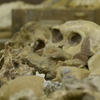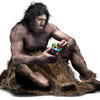You are here
Was Toumaï a biped?

From the discovery of Lucy in 1974 until the 1990s, paleoanthropologists generally agreed on the hypothesis that humanity appeared in East Africa (Ethiopia, Kenya, Tanzania, etc.) five to ten million years ago, following climatic and environmental upheaval. Popularised by Yves Coppens under the name “East Side Story,” this theory began to be called into question by discoveries made by a French-Chadian team involved in an excavation programme located west of the usual sites, in Central Africa. The team, which was led on the French side by Michel Brunet from the Laboratory Palaeontology, Evolution, Palaeoecosystems, Palaeoprimatology 1 (Palevoprim) in Poitiers, unearthed fossils in Chad of an Australopithecus–nicknamed Abel and dating back approximately 3.5 million years, thus older than Lucy–as well as the skull of a specimen from the previously unknown genus of Sahelanthropus tchadensis, dating back approximately seven million years. The skull was nicknamed Toumaï, a name that means “hope of life” in the local language.
“It is one of only three hominid genera that existed five to ten million years ago in Africa, along with Ardipithecus and Orrorin,” points out Clément Zanolli, a member of the From Prehistory to Present Time: Culture, Environment, and Anthropology Laboratory2 in Bordeaux. “This makes it, in theory, a possible ancestor of the subtribe Hominines, which includes modern humans.” This would make it the oldest direct ancestor for humanity ever discovered. “That is one hypothesis, but there are others,” tempers Zanolli. “Nor can we exclude that it is from a lineage closer to chimpanzees and gorillas than to humans, or that it is a ‘dead branch.’” This expression refers to a species that became extinct without leaving behind descendants into the present.
Hypothesis in 3D
In the early 2000s, Michel Brunet and his teams published a first analysis of the skull and jawbone fragments discovered at the site. According to them, this new species resembles humans more than chimpanzees, which would place it within our lineage. The skull structure of Toumaï struck them as being coherent with an essentially bipedal form of locomotion, whereas non-human great apes most often move on four limbs. “This interpretation was notably based on 3D reconstructions of the skull,” summarizes Franck Guy of the Palevoprim Laboratory. “The occipital hole, where the spinal column connects with the skull, has a centred position that suggests a perpendicular inclination in relation to the ground, characteristic of humans.” Among primate quadrupeds it is the opposite, as the occipital hole is more often located towards the back of the skull, with which the spinal column forms a more acute angle.

Concretely, primates need to direct their gaze forward in order to find food, identify danger, and survive. The position of their eyes–the “orbital plane”–is therefore not the same if they move around on two legs or on all fours. “Yet I would not necessarily use the word ‘bipedalism’ for the skull of Toumaï,” continues Guy, offering nuance, “but more precisely of potential orthograde posture.”
The difference is not just semantic. In the strict sense of the word, bipedalism refers to the ability to walk on two limbs, which all great apes are able to do, just as humans can occasionally walk on all fours if they choose to. If we push the ambiguity further, other animals, such as most birds, are bipeds, but have an anatomy that is very different from that of primates, in particular a spinal column that is almost parallel to the ground when they move.

Orthograde posture is therefore a more specific anatomy, apparently reflecting an adaptation to a particular form of posture or locomotion, and coherent with bipedalism. “The skull structure of Sahelanthropus tchadensis suggests that a posture that is vertical and perpendicular to the ground was one of its preferred forms of locomotion,” stresses Guy.
At the time, other indications called for its inclusion within the branch of the Hominines. For instance, the jaw remains of Toumaï seemingly include small canines, whereas these teeth are larger and more prominent among other great apes. Smaller tooth size among humans–what paleoanthropologists call the “loss-of-function honing complex”–is generally an important criteria of distinction for Hominines. “There is a whole series of minor indications,” details Guy. “The morphology of the face, its articulation with the neurocranium, the anatomical structure of the ‘nape.’” In general, paleoanthropologists never rely on just one criterion in determining whether a specimen belongs to the human lineage or not. “It is always a combination of criteria and how we interpret them that tips the scales one way or another, or in any event that should be the case.”
Twenty years of debate
The discovery of a new hominin species was a small revolution in the 2000s, but it also sparked debates. Firstly, other fossils were discovered at the excavation site that could call into question the bipedalism of Toumaï. A controversy notably emerged around a femur and two forearm bones (ulnae), which were not immediately identified and analysed by Brunet’s teams. “According to a study3 led by the anthropologist Roberto Macchiarelli and published in 2020, the femur seems to have a pronounced curvature, closer to that of great apes that usually walk on all four limbs,” underscores Zanolli. This analysis clearly challenges the bipedalism of Toumaï, and more generally its inclusion within the human lineage.
Another scientific article4, published in 2023 by the anthropologist Marc Meyer (from the Department of Anthropology at Chaffey College in the United States) and his collaborators, argues that the ulnae are more similar to those of great apes that use their knuckles to move about, what primatologists call “knuckle-walking.” “More generally, the bones of the skeleton provide numerous indications suggesting that Toumaï resembles chimpanzees and gorillas more than humans, suggesting a habitual non-bipedal form of locomotion,” adds Zanolli.

In addition to diverging interpretations as to the nature of the fossils, there have been methodological debates as well. “The position of the occipital hole connecting the skull and the spinal column was the first argument proposed as proof for the bipedalism of Sahelanthropus. However, the skull is highly deformed, and 3D reconstruction of the skull of Toumaï was completed twenty years ago. It was a new method at the time, but the discipline has evolved since then. Today it is believed that these earlier manual methods do not provide a reliable reconstruction. The skull of Sahelanthropus should be reconstructed with the more objective modelling approaches used today.”
Multiple forms of locomotion?
In 2022, the paleoanthropologists Guillaume Daver, from the Palevoprim Laboratory, and Franck Guy published a new article in the journal Nature5 on the fossils of Sahelanthropus tchadensis and its forms of locomotion. “In the scientific literature, the definition for ‘habitual bipedalism’ tends to vary greatly from one author to another,” says Guy, offering context. “We therefore firstly proposed clarifying this notion.” According to this study, the habitual character of bipedalism should be considered in light of an adaptive trajectory. In other words, the key issue is not to prove that the anatomy of Sahelanthropus tchadensis allowed it to move in a particular fashion, but to determine whether its skeleton presents signs of biological evolution typical of bipedal species. “With Guillaume Daver, we identified fifteen criteria, such as the thickness of the cortical bone or the shape of the calcar femorale, a small bony ridge in the hip.” These anatomical structures provide invaluable information regarding the stress and tension exerted on a body during its lifetime, and hence on its forms of locomotion.



“In general, the anatomy of Sahelanthropus tchadensis has more elements in common with bipedal homininssuch as Australopithecus, Orrorin, and Ardipithecus, than with chimpanzees and gorillas,” Guy concludes. Still, this does not exclude other forms of locomotion. The study argues that Sahelanthropus tchadensis adopted an “assisted” bipedalism in trees, using its lower limbs for support and helping itself with firm handholds. It apparently also opted, once again atop trees, for a slow and cautious quadrupedalism, with all limbs on one branch, like orangutans. “However, in more ordinary situations on the ground, we can reasonably think that it chose bipedalism as its default form of locomotion,” Guy stresses.
Diverging interpretations
The debate continues today. A new article published this year in the Journal of Human Evolution6 proposes a critique of the study by Guillaume Daver and Franck Guy, and more generally argues that Toumaï “was probably not a habitual biped,” explains Zanolli, who took part in this research effort. “We wanted to give greater consideration to anatomical criteria, and to include a larger number of primate species in our analyses.The central issue was to better understand how Toumaï fit into this evolutionary history.” The researchers especially observed that the femur is sturdy and curved, as is the case with quadrupedal great apes. Similarly, the torsion of the diaphysis (long section in the centre of the bone) is greater than among humans.

The criteria used in the article by Guillaume Daver and Franck Guy have also given rise to diverging interpretations. “The calcar femorale has a column-shaped and oblique morphology, which is not only observed among humans, but also documented among great apes,” adds Zanolli as an example. “In general, the limbs of Toumaï have proportions and configurations that are closer to those observed among chimpanzees and gorillas. We believe the most prudent conclusion would be that Toumaï probably did not prefer bipedalism.”
If the debate still rages, it is because bipedalism remains a criteria with powerful symbolic weight, still associated in the collective imagination with the transition from animality to humanity, even as the scientific research of recent decades has broadly established that what is “uniquely human” is not so easy to define. “Bipedalism is a useful but not necessarily crucial characteristic,” Zanolli specifies. “One can well imagine, for example, that some of our most distant hominin ancestors did not habitually walk on two legs.”
He believes that new analyses of the fossils of Toumaï, such as study using X-ray scanners, could move the debate forward. Most importantly, the discovery of new fossils contemporary to Toumaï, ones that are more complete and less damaged, would help provide a more complete image of its anatomy and way of life. As for Franck Guy, he has launched an excavation programme in Chad with his local colleagues and those from Poitiers, with a view to discovering new specimens.
Further reading on the CNRS News website
Shedding new light on the adventure of humanity
Explore more
Author
Fabien Trécourt graduated from the Lille School of Journalism. He currently works in France for both specialized and mainstream media, including Sciences humaines, Le Monde des religions, Ça m’intéresse, Histoire or Management.















